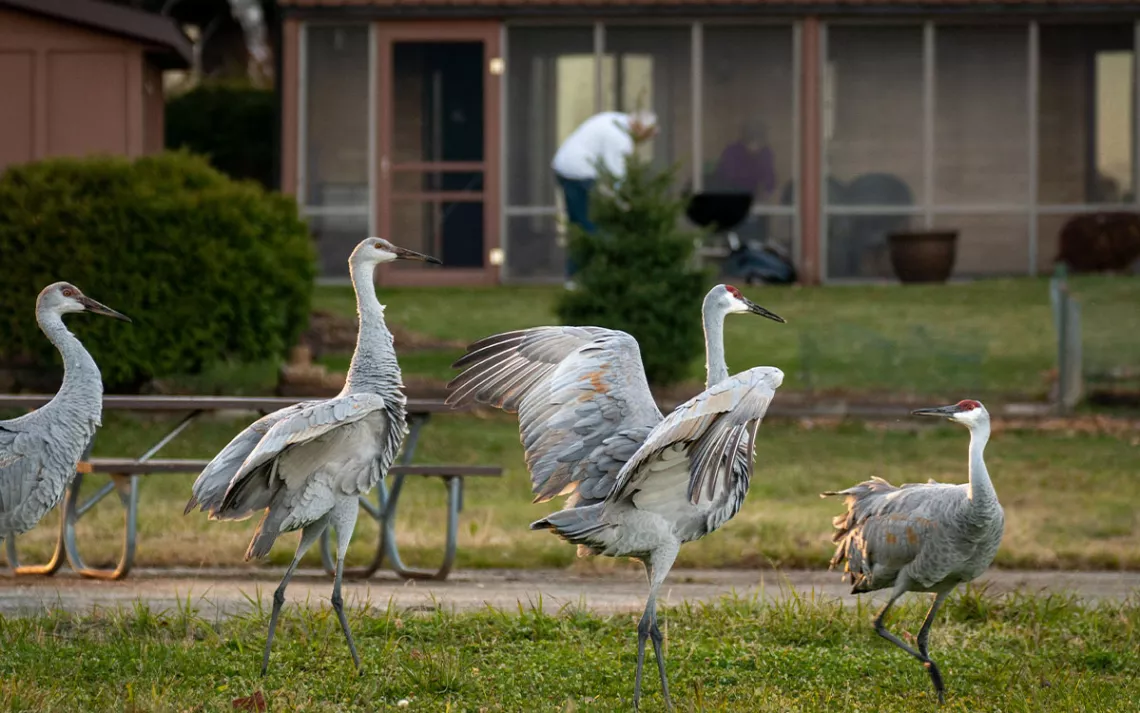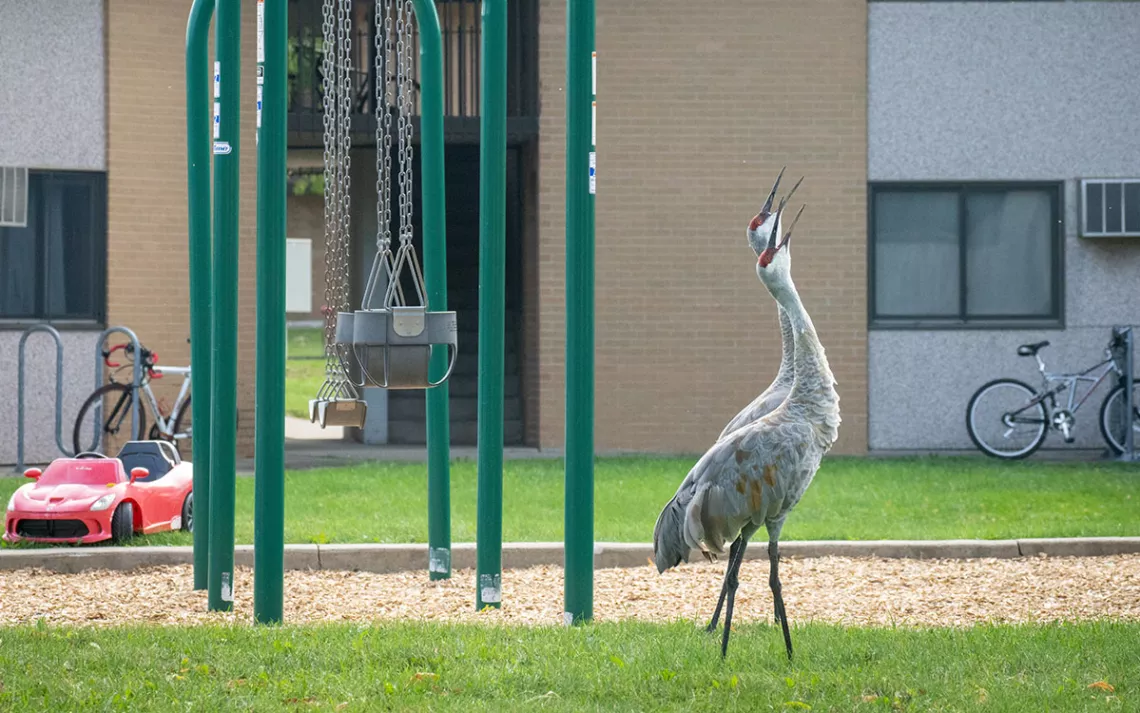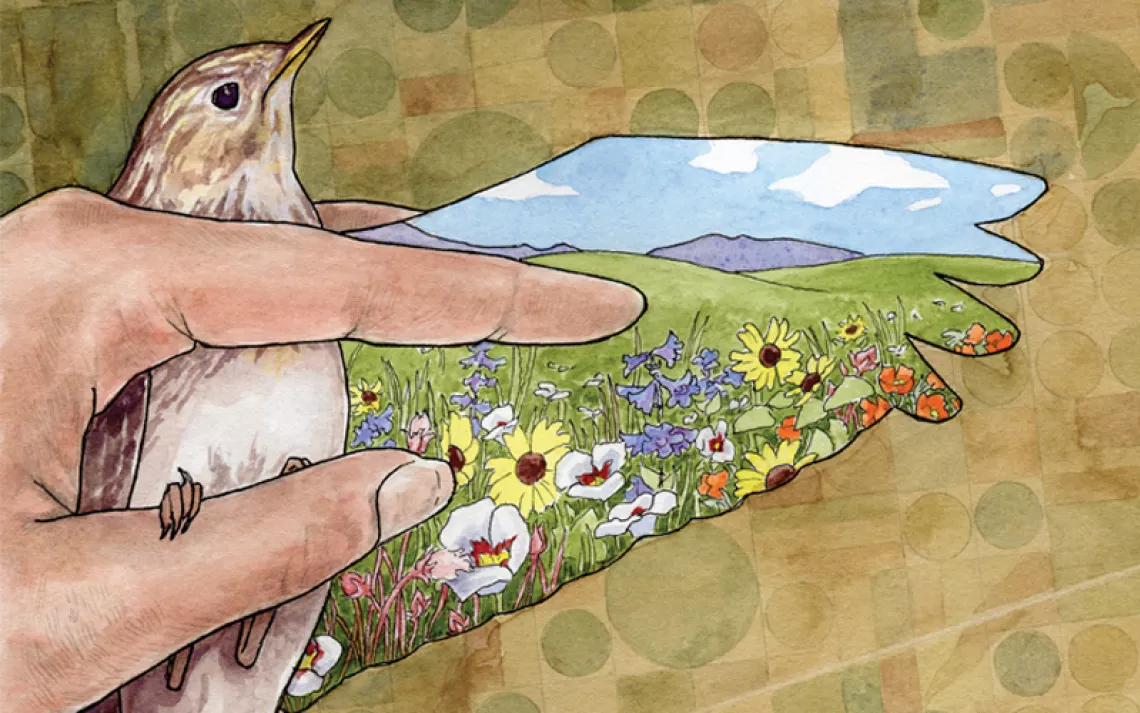Sandhill Cranes Are Moving to Cities and Adopting Urban Lifestyles
Once elusive inhabitants of remote wetlands, sandhill cranes can now be found thriving in yards, athletic fields, and college campuses

Photos by Anne Readel
Trumpeting calls echoed across the bustling University of Wisconsin campus in Madison. A pair of sandhill cranes had taken up residence in the local marsh. Throughout the summer, the pair and their two tawny chicks could be seen meandering across the campus’ lawns and playing fields, seemingly unfazed by the steady stream of bikes and cars and the throngs of ogling onlookers snapping photos.
Urban crane sightings, such as those on the University of Wisconsin campus, are no anomaly. The towering four-foot-tall birds are now routinely found in athletic fields, cemeteries, and backyards throughout Wisconsin. But this wasn't always the case.
Sandhill cranes have graced this planet for millions of years. However, nearly a century ago, the species was on the verge of extinction. In Wisconsin alone, only a few dozen breeding pairs remained. They had become so rare that conservationist Aldo Leopold lamented their impending demise in A Sand County Almanac. Thankfully, Leopold’s predictions did not come to pass—habitat restoration and hunting reform ultimately saved sandhill cranes, allowing their populations to rebound in Wisconsin and throughout their range.
Today, sandhill crane populations are booming. According to the International Crane Foundation, a whopping 1.7 million sandhill cranes inhabit North America with over 100,000 in the eastern population, which mostly breed in Wisconsin or pass through the state on their way to breeding grounds in Ontario, Canada. The species’ dramatic recovery has led them to be hailed as one of America’s greatest conservation success stories. It has also brought them into much closer contact with people.
As sandhill crane numbers soar, they’re running out of natural habitats and expanding their range into urban areas, which have historically been considered risky habitats, explains Richard Beilfuss, president of the International Crane Foundation. Indeed, while scientists surmised that urban sprawl would lead populations of these impressive birds to plummet, research shows the opposite.
Michael Ward, a professor at the University of Illinois, studied urban sandhill cranes in Wisconsin and Illinois. He found that urban cranes were actually more successful in raising chicks than their rural counterparts. In fact, the urban birds he studied were so successful in raising young that their population trajectory mirrored that of more familiar urban denizens. “They’re breeding in wetlands in people’s backyards … it’s analogous to what Canada geese are doing,” says Ward.

Sandhill cranes' urban success may be tied to altered predator behavior. Raccoons and coyotes— common crane chick predators—are often abundant in urban areas, but they may be less likely to go after chicks since humans (often inadvertently) supplement their diets. “Raccoons can eat french fries, coyotes can chase people’s cats, that sort of thing,” says Ward. And none of those things require fighting off an angry crane mom to nab a chick.
Although sandhill cranes are showing remarkable adaptability to urbanization, preserving natural wetlands is still important, stresses Tim Dellinger, an assistant research scientist at the Florida Fish and Wildlife Conservation Commission. Sandhill cranes in the Midwest readily nest in manmade wetlands, such as retention ponds choked with cattails, but that hasn’t been the case in Florida. Dellinger found that sandhill cranes in the Sunshine State—a separate population from birds in Wisconsin—still predominantly rely on natural wetlands for nesting and roosting. But, like their midwestern counterparts, they have a penchant for venturing into nearby lawns around homes, colleges, strip malls, and church yards to search for worms, raid bird feeders, and accept handouts from their adoring human fans. “They’re adapting to this radical change, and they’re finding a way to survive,” says Dellinger.
Despite easy pickings, life isn’t trouble-free for city birds. Sandhill cranes face different threats in urban areas—they can be hit by cars, electrocuted by power lines, become entangled in garbage, or even inadvertently stepped on. One days’-old chick I was photographing on the University of Wisconsin campus was almost squashed by a passing pedestrian glued to her cellphone (she never even noticed the baby!). However, sandhill cranes are getting street smart, either through learning or natural selection.
Since cranes are long-lived animals that return to the same area to nest year after year, they learn how to use their surroundings, explains Ward. Indeed, Dellinger recalls one crane family that lived next to a busy six-lane highway. It learned to navigate the area, something that he saw birds from nearby roadless conservation land attempt unsuccessfully. The cranes from the conservation land were hit by cars and killed within a few days of venturing close to the high-traffic area.
While cranes may be learning how to navigate city obstacles, navigating their new relationship with humans remains tricky. The big birds can dig up lawns and gardens looking for worms, damage vehicles and windows by pecking at their reflections, and generally get into mischief. “We had a report of a sandhill crane in someone’s garage once,” says Ward. “It walked in there and was eating out of their trash can.”
Although stories of trash-raiding cranes may elicit laughs, such interactions are risky for all involved. Cranes can be aggressive, especially when squeezed into areas full of people. In Florida, a nine-year-old boy was attacked by a cranewhile riding his bike to school in a residential neighborhood. In Wisconsin, a crane was shot by police officers after they received complaints that the crane was pecking at cars. These are examples of what can happen when the birds become overly urbanized, says Beilfuss. “In almost all cases, we’re the ones attracting them in with feeders.”
When people intentionally habituate cranes, it further compounds the problem. Beilfuss recounts a conversation with a woman who said she loved cranes, fed them every day at her backyard feeder, and was able to get so close that she could pet them on the head. “It kind of epitomizes the challenge,” he says. Similarly, Dellinger notes that while Florida has made it illegal to feed sandhill cranes, “people just ignore that … it’s kind of frustrating.”
Experts note that simple steps can minimize negative interactions with these impressive birds. “Don’t feed the cranes, don’t touch the cranes … and don’t take selfies with cranes,” stresses Beilfuss. Property damage can also be prevented by covering cars so the birds can’t see their reflections or by putting up temporary fences to keep cranes out of yards and away from windows, says Dellinger.
Faced with extinction only a century ago, sandhill cranes are one of America’s greatest conservation success stories. They offer a glimmer of hope that (at least some) wildlife can adapt to our rapidly changing world. New relationships aren't always easy, but this one holds a lot of promise. “People love them, you know, and that’s the upside of this urbanization,” says Beilfuss. “They’re really in people’s lives the way our feeder birds are.” Whether these majestic birds are ultimately able to succeed living among us may depend on whether we can refrain from loving them to death.
 The Magazine of The Sierra Club
The Magazine of The Sierra Club



